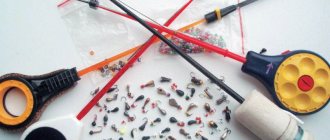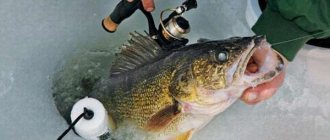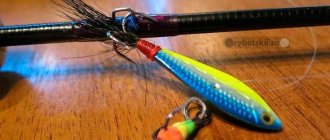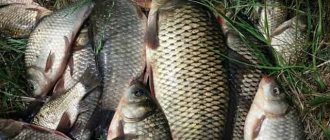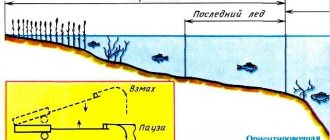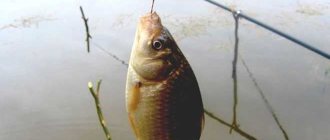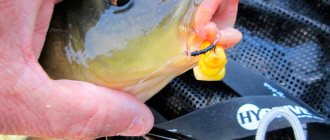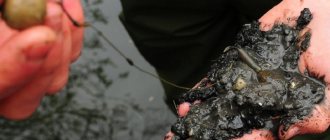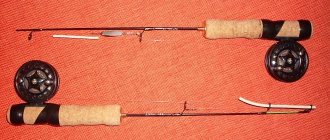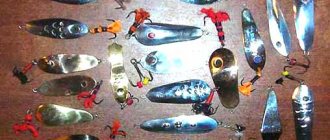Winter fishing is not to the liking of every fisherman, or, if you prefer, within the capabilities. But in reality, only those fishermen who have never tried to catch fish from ice don’t like it. I myself, to be honest, until I went on winter fishing, I didn’t understand how fishing in the snow, cold and with almost a complete lack of any comfort could be interesting. After all, I’m used to fishing in the warm season, always with an overnight stay, a fire, and, if you’re lucky, even a barbecue.
But when I went ice fishing for the first time, I didn’t notice how time flew by! I was so drawn into this exciting fishing. Everything was new for me - the method of fishing, gear, fishing style, searching for fish and drilling holes. Now winter fishing is an integral part of my leisure time.
I gained a lot of experience and fished in the winter with many experienced fishermen - my friends and colleagues. And in this article I would like to share with you my knowledge about winter baits. Lures for winter fishing are not as varied as summer ones, but if you are going to fish from ice, you should be aware of which baits will be useful to you and what to expect from them.
What to fish with in winter
I would like to note that even experienced fishermen do not always understand the difference between attachments and baits. So, in this article we are talking specifically about bait, that is, bait of animal origin. For those who didn’t know, I’ll say that baits are baits of plant origin.
The following are most often used as winter baits, and therefore are the most catchy:
- bloodworm;
- maggot;
- worm;
- mormysh.
Now, to my great joy and, I’m sure, all fishermen, buying bait for winter fishing in a fishing store is not difficult. Well, maybe there may be problems with worms and jigs in some regions. But maggots and bloodworms are almost always available.
With these 3 baits you can fish for almost any fish that can bite in winter. You can take one thing for fishing, or you can take all of them together. If you take various baits, you get an undeniable advantage.
- Firstly. The fish can be picky and will only bite on, say, bloodworms on the day of fishing. And if you only have maggots, you will deprive yourself of successful fishing with your own hands.
- Secondly. Perhaps the fish on the day you go out on the ice will actively bite on sandwiches, and you only have one bait. A sandwich is the simultaneous placement of both maggot and bloodworm (maggot and mormysh) on a hook. Often this technique allows you to activate the bite of inactive fish.
- Third. The preferences of fish can change even within one daylight hours. That is, in the morning the fish could actively feed on bloodworms, and in the evening give them maggots.
Basically, you've realized that having just one bait can significantly reduce your chances of making a big catch. Now let's take a closer look at the listed baits.
Mormyshka
What should it be like to be an irresistible bait for fish? It is unlikely that anyone will undertake to answer this question in each individual case.
The bite to some extent depends on the shape of the jigs (if they have significant differences). For example, the play and vibrations in the water are different for spherical and flat jigs, therefore, the bite on them in certain conditions will be different. So the choice of bait shape is dictated by fishing conditions. On jigs that are similar in shape, for example “Drobinki” and “Droplets”, the bite is usually equivalent, but on a “Plate” the effect may be the opposite.
Recommended reading: Details about choosing and using a spinning rod for long-distance casting from the shore
If we talk about the color of the jig, then the authoritative established opinion is that in clear weather, as a rule, dark baits work better, and in cloudy weather, light ones work better. But here, as they say, options are possible. One of the fishermen once conducted special research in this area and concluded that fish prefer lemon color. However, no one catches with lemon-colored jigs, but beads or lemon-colored cambric, put on the shank of the hook, give a clear positive result.
By size, jigs of the same type can be divided into three groups: small - about the size of a match head (1.5-2 mm in diameter), medium - about 2.5-3 mm and large - 4 mm or more. Accordingly, hooks are placed on them: for small ones from No. 1.5 to 2.5, for medium ones - No. 2-3.5, for large ones - No. 3.5-5.
Handling of hooks is very important. Fishermen usually poison them themselves in a mixture of hydrochloric and sulfuric acid, and then sharpen and polish them to such an extent that the hook seems to stick to the fish’s mouth. The quality of the sharpening of the hook is checked under a magnifying glass. On a well-honed thin hook, such delicate bait as small bloodworms and burdocks are put on almost without damage, and this is very important, since in winter the fish is much more capricious than in summer, and is sensitive to any flaws in the tackle. Craftsmen manage to release the hook material, then bend it (change the size) and harden it again, which is especially necessary when you need to attach a hook to a small jig.
Since life, as they say, forces fishermen to remake hooks, it is not surprising that they also make jigs themselves. Maximum weight with minimum size - this is the main requirement for a jig. Most of the best jigs are made from waste heavy materials, the density of which is almost twice that of lead. But everyone who has dealt with such material knows that making a jig from it is so difficult that few people succeed without special tools. Heavy metals are very poorly processed and cannot be soldered with tin at all without first being coated with galvanic copper. Currently, tungsten jigs are being produced. They have sufficient mass with a small size, but have a slightly rough shape.
Jigs of all types are tied to a hook when there is complete confidence that during fishing the sharp edges of the hole in the body of the jig will not fray the fishing line. If there is no such confidence, then it is more reliable to tie the jig, as shown in the same figure, first threading the fishing line through the hole three times and only then tying it to the hook. But you can do it differently: make the hole in the jig somewhat larger (about 0.8 mm) and insert a piece of thin radio insulation (cambric) there, leaving some allowance. Then it is enough to thread the line once and not be afraid that it will fray.
A complaint often made about heavy jigs is that in any shape they play only vertically, whereas in most cases a combination of movements in both vertical and horizontal directions is required. Therefore, in recent years, many have successfully begun to use jigs, which are similar in shape to miniature spoons, which, with the appropriate nod action, move up and down and to the sides, and the fish bite on them noticeably more actively. Such jigs are classified as gliding jigs; they are made of relatively light metals - copper or brass, and are usually used in shallow water. Their main feature is the location of the hook: it should protrude as little as possible from the body of the jig, and the hole for the fishing line should be shifted to the rear. Such baits, like spinners of the same type, work differently, and sometimes seemingly completely similar jigs give different results. The best bait for them is burdock and small bloodworms, but adding large bloodworms often worsens the performance of the jig and reduces its catchability.
Shown are jigs that have become widespread relatively recently. They are more often caught with cambric of different colors, without bloodworms, the body of the jig is painted black, but lately “devils” of other colors have been found. The fishermen's imagination has gone even further. Now jigs with four hooks called “Witch” have appeared, and among fishermen there has been a division into “devils” and “witchers”. Everyone has their own theory of fishing, their own successes and disappointments. There is an assumption that these jigs are more similar to jigs than other baits. For example, the “Goat” jig, in its arrangement of hooks and its play, resembles the behavior of aquatic insects – “boogers”, which is why it got its name.
Bloodworm
A bloodworm is the larva of a mosquito. This is the main food supply for fish in almost any body of water. Bloodworms work great in any body of water when catching any type of fish, with the exception, of course, of such fish species as catfish, pike, pike perch (of course).
If the bite is weak, a technique such as using a bloodworm + maggot sandwich often helps. You can put a maggot-bloodworm-maggot on the hook, or a bloodworm-maggot-bloodworm. In principle, there is not much difference, but sometimes the fish are so finicky that a specific combination of bait works better.
It is not difficult to place a bloodworm on a hook or jig, but it is quite inconvenient due to the fact that its body is very thin, and even wriggles during installation. You can find out how to attach a bloodworm to a hook or jig here.
You can buy bloodworms at any fishing store. To keep it alive and suitable for fishing, if you purchased it in advance, you just need to wrap it in a damp cloth and place it on the bottom shelf of the refrigerator. If the family is opposed to storing bait in the refrigerator, you can use the balcony, but there is a risk that the bloodworms will not last so long there.
Maggot
Maggot is the first competitor of bloodworms in winter fishing. Anglers most often combine these two most popular winter baits. But maggots have certain advantages over bloodworms, at least that they stay on the hook much better. If the bloodworm may require replacement after the first bite, then you can catch a dozen fish with one maggot and it will be able to continue to delight you with a new catch.
Just like bloodworms, maggots can easily be purchased at a fishing store. You can learn how to place maggots on a hook here. Any peaceful fish, as well as ide, perch, ruff, etc., readily take maggots.
It is necessary to store maggots in a jar or box with air holes in a cool place. In order for maggots to be stored as long as possible, they need to be sprinkled with sawdust, semolina or flour and periodically fed with raw meat or fish. In a cool place, that is, in the refrigerator or on the balcony, the maggot falls into a stupor, and when it gets warm again, it comes to life.
If some larvae have pupated, do not rush to get rid of them; in some reservoirs, fish begin to bite even more intensely on pupated maggots. Well, as mentioned above, maggots can be successfully combined on the same hook with bloodworms, creating so-called sandwiches.
Mormysh
Another effective bait for winter fishing is jigs, also known as amphipods. It is not common in fishing in all regions, but it is a very good and reliable bait. Almost all peaceful fish and even predators - perch, small pike perch and pike - bite on jigs.
You should put the jig on the hook from the inside, starting to pierce it through the head along the entire body. This bait can also successfully manifest itself in a sandwich with bloodworms or maggots. Depending on the reservoir, the best bite can be observed when fishing with a pure jig, with a jig with maggots, or with a jig with bloodworms. Mormysh can be stored in the refrigerator on the bottom shelf in containers with holes for oxygen access.
Unfortunately, you can’t buy mormysh in all stores, but if there is such a store in your city, then you are very lucky. Indeed a very suitable winter bait.
Fishing rod
With the help of this miniature fishing rod, the jig is given the necessary movements (game), hooking the fish, and absorbing its jerks. The fishing rod should be as light as possible and allow the line to be wound and reeled in and out quickly and freely. Of the variety of designs, anglers prefer two, which we will get acquainted with.
The first type of fishing rod is relatively simple and is intended for blind equipment. Its handle is made from cork (you can use it from wine bottles), which is drilled to the diameter of a 4-5 mm tube (one of the elbows of a telescopic radio antenna), the ends and holes are covered with BF-2 glue or epoxy resin, placed on this tube, and pulled together ( if the workpiece consists of separate parts), they are dried and then processed on a lathe or by hand.
In the body of the handle, using a knife or drill sharpened for a milling cutter, grooves for the reel are selected, cork or wooden plates are glued in, which are given the appropriate shape, and the areas of the reel darkened in the figure are covered with epoxy resin, as a result of which their surface becomes so smooth that when reeling in the fishing line runs away from them like from the drum of an inertialess reel. Cork reels have some elasticity, so the fishing line that dries on them is slightly deformed; at the same time, the resin protects the cork so that the fishing line does not cut through it. The mushroom shape of the upper (closest to the whip) reel allows for fine-tuning the amount of descent: if necessary, you can wind the line not on the entire reel, but only on this part.
You should not paint the handle or varnish it: it will lose its velvety, natural feel that is pleasant to the hands. Before the start of the season, the handle is refreshed with fine sandpaper and any irregularities on the reels are smoothed out.
The whip is made from vinyl plastic. Its approximate design is also shown in Fig. 2. It should be flexible enough to at least partially dampen sharp hooks, which are the cause of most line breaks.
The fishing rod is easy to manufacture, lightweight (from 10 to 15 g), compact, allows the line to move freely and quickly when necessary, accurately adjust the descent, reliably and conveniently retains the jig and nod, and finally, it is “butt-friendly”, that is, it fits well in the hand. The disadvantages of this fishing rod include the fact that the line on it is open. Indeed, in frosty weather, ice flakes freeze on the fishing line remaining on the reel, which grab it so tightly that without first sucking or biting the ice floes (and there are no other techniques), it is impossible to change the descent without risking breaking the thin tackle. Another drawback is the lack of automatic line release when the fish pulls hard.
Recommended reading: Equipment
The second type of fishing rod is free from these disadvantages. Its body, which houses the reel, is also a handle. Although its shape is far from classic, it has additional important qualities: smooth, easily adjustable braking of the reel, which almost completely eliminates line breakage when catching large fish, and quick and precise adjustment of the release. Of course, it is structurally somewhat more complex than the previous one, and also heavier (24-26 g). Its handle is made of foam plastic and painted bright red; the fishing line reel is an integral part of the handle and has an extremely large diameter (a further increase in it would lead to disruption of the harmony of the gear). The reel drum is machined from corporal. The rod, fastening and adjusting screws, and the socket for the whip are made of nylon or polyethylene.
There are similar designs on sale, but they are not without drawbacks: cold plastic body, lack of a smooth brake, large gap between the body and the reel. However, fishermen have learned to remake factory fishing rods.
On a piece of hard foam measuring 25x100x120 mm, a pattern of the future fishing rod is applied according to the template. Using a large drill or cutter with a diameter of 55 mm, make a sample with a depth of 17 mm. A specially made metal stamp is also suitable for this, which, when heated, is fixed in the chuck of a drilling machine and is gradually pressed into the foam.
The body is cut out using a jigsaw along the drawn contour. The whip holder and handle are cut off from the factory fishing rod (“Saturn-3”). The remaining coil is adjusted to the socket, lightly sanded, coated with epoxy glue and connected to each other in place. The glue should abundantly fill all the recesses between the foam and the coil body.
When the glue has dried, a small diameter hole for the whip is drilled in the center of the inserted reel body, and then using a 10 mm drill along the intended small hole, a socket is made for the previously cut holder of the whip, into which it is inserted using epoxy glue. The glue is allowed to dry and another hole is drilled with a small drill - along the whip holder for passing the fishing line (its diameter is for a cocktail straw or a ballpoint pen tube). The finished fishing rod is processed with a file and sandpaper, and painted in a bright color.
The fishing rod turns out to be portable, beautiful, lightweight, and fits well in the hand thanks to the side protrusions, which are convenient for winding fishing line when moving from hole to hole.
In general, a competent fisherman should have 10-12 fishing rods for various rigs.
The nod “guards” the bite and, with its vibrations, gives the jig a playful feel. At the same time, it is very important that the fishing line passes through it freely, and that it itself does not participate in hooking, does not break or deform from frequent impacts on the ice, and does not change its elasticity depending on the air temperature.
A piece of rubber insulation 1 from a high-voltage cable consists of two layers: the upper one is a thin vinyl chloride sheath, under which a plastic plate, a narrow strip from an x-ray or boar bristle is pulled 2, and the lower, main one, into the hole 3 of which a cambric is inserted using a sewing needle ( vinyl chloride sheath from a single-core telephone wire), and a fishing line passes through it.
The most important part of the nod is an elastic plate made of elastic plastic. Boar bristles are also good if you choose them carefully. The fact is that most of them are rectangular in cross-section and are not suitable, but you need to select round ones that work better. But, it’s true, And they fail quite quickly - they delaminate from impacts on the ice. In addition, the bristles have different elasticity in different areas, which also negatively affects the operation of the nod. Therefore, many anglers have switched to nods made of steel springs or thin plastic plates, and they prefer white plates with a thickness of 0.10-0.25 mm. But both of them have drawbacks: the springs quickly rust and break, and poorly processed plate chamfers sometimes cut the fishing line.
The elasticity of the nod depends on the width, length and thickness of the plate and is selected depending on the weight of the jig. The nod cannot be universal both in relation to the jig and in relation to the type of fish. For example, when fishing for perch, short and soft nods are good, white fish (bream, roach) are longer and more elastic, since the optimal vibration frequency (play) of the jig is different for them. Some fishermen place the nod at an angle to the whip; to do this, the vinyl plastic tip is bent in hot water at a selected angle.
The fishing line used for winter jig fishing is very thin (0.08-0.15 mm), which means the quality must be very high.
When a knot forms on the fishing line while fishing and is pulled tight, you should not untie it: anyway, the fishing line in this place will be deformed and may fail at the decisive moment. If the knot is located close to the jig, it is better to tie it up immediately, and remove the excess part of the line up to the knot. In summer it can be used on leashes. Another piece of advice: when starting a new season, be sure to check the quality of last year’s fishing line, and to avoid guessing later what kind of fishing line is on the fishing rod, stick a piece of adhesive tape to the fishing rod and write on it the diameter of the fishing line and its length.
